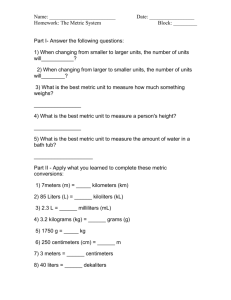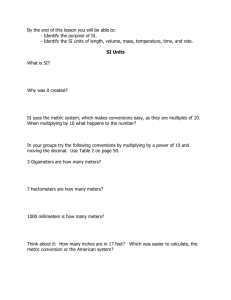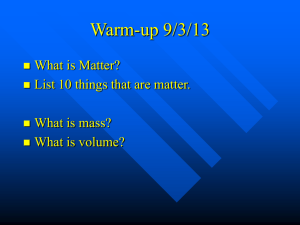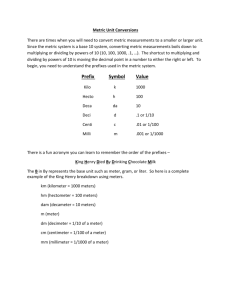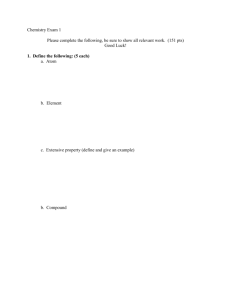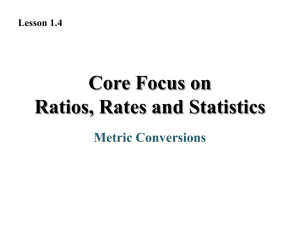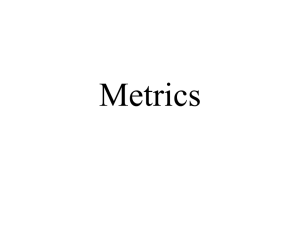9/9/02
advertisement
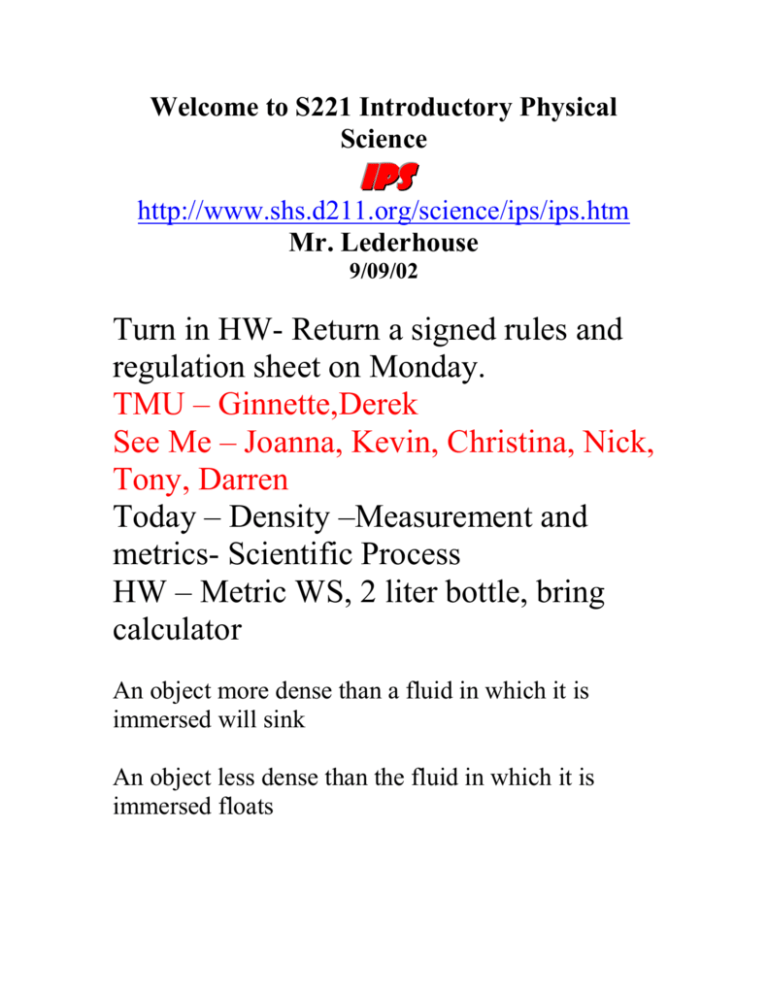
Welcome to S221 Introductory Physical Science IPS http://www.shs.d211.org/science/ips/ips.htm Mr. Lederhouse 9/09/02 Turn in HW- Return a signed rules and regulation sheet on Monday. TMU – Ginnette,Derek See Me – Joanna, Kevin, Christina, Nick, Tony, Darren Today – Density –Measurement and metrics- Scientific Process HW – Metric WS, 2 liter bottle, bring calculator An object more dense than a fluid in which it is immersed will sink An object less dense than the fluid in which it is immersed floats An object with density equal to the density of the fluid in which it is immersed neither sinks or floats ( neutrally buoyant) Magic Circle m D V Density = mass/volume D=m / V (grams/ml) V= m/D m= DV Density is a property of all matter. For a given material, the density is a constant (does not change). Density is the ratio of an objects mass to the space it takes up (volume). If you take a sheet of aluminum foil and rip it up, the density of each piece (regardless of size) is the same as the original sheet, which s the same for any size sample of aluminum 2.7 g/ml For water, density = 1 gram/ml aluminum 2.7 g/ml alcohol 0.81 g/ml ice 0.92 g/ml iron 7.86 g/ml lead 11.3 g/ml gold 19.3 g/ml 1 ml = 1 cm3 = 1 cc Problem Solving Steps 1) ID VARS – identify the Variables 2) Write the correct form of the equation ( use Magic circle) 3) Substitute values and units into the equation 4) Calculate the answer with units (NO NAKED NUMBERS) 5) Check – Does the solution make sense. Scientific Process OBSERVING Metric Pre-Test Choose the Best Estimate 1. A typical temperature for a July day in Chicago is a. 31°C b. 90°C c. –5°C 2. A typical temperature for a January day in Chicago is a. 30°C b. 90°C c. –5°C 3. A typical room temperature is a. 0°C b. 75°F c. 70°C 4. The freezing point of water is a. 30°C b. 15°C c. 0°C 5. A full size sofa has a length closer to a. 200 cm b. 200 mm 6. Chris Farley has a waistline of a. 120 cm b. 120 m 7. A boom box has a weight of a. 300 g b. 3 kg 8. A normal drinking glass contains a. 200 ml b. 200 l 9. How much snow do we need for a snow day? a. 2 cm b. 2 dm c. 2 meters 10. A St. Bernard weighs a. 75 g b. 75 kg Metric Tidbits 1. Ladies, if your measurements were 92-61-90 centimeters, what kind of response would you expect from the men? 2. A record waist measurement is 300 cm. How does yours compare? 3. There was once a man almost 3 meters tall. Could we use him on the basketball team? 4. Would a person with a foot 47 centimeters long be considered petite? 5. If you weigh 225 kilograms, do you think it's time to diet? 6. There was once a man whose hair was over 79 decimeters long; how does this compare with Mr. L.? Metric System Advantages Three basic units of measure Length – meter Mass – grams Volume – liters Easy conversions for different sizes using prefixes – Powers of 10 10 –100-1000-10000…. .1 -.01- .001 - .0001 …. 1. Find your starting stair step (km) 2. Find your finish stair step (cm) 3. Count the number of steps you walk to the finish position (don’t count the step you start on) and the direction that you moved (Up or Down). (5 steps down) 4. Use the DRUL (Drool) method. Move the decimal point the same number of decimal places as the number of steps that you moved and move in the direction that you walked. Add zeros as needed. Down Right Up Left -------> DRUL 1.245 km = 124500.0 cm K- kilo 1000 H - hecto 100 D - Deka 10 meters grams liters d - deci 1/10 = 0.1 c - centi 1/100 = .01 m - milli 1/1000 = .001

